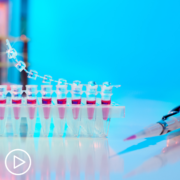Fact or Fiction? Myeloma Treatment & Side Effects from Patient Empowerment Network on Vimeo.
When it comes to online myeloma information, how do you separate fact from fiction? Dr. Irene Ghobrial shares facts about current myeloma treatments, common side effects and emerging research. Download the Program Resource Guide, here.
Dr. Irene Ghobrial is Director of the Clinical Investigator Research Program at Dana-Farber Cancer Institute and Professor of Medicine at Harvard Medical School. Dr. Ghobrial specializes in multiple myeloma (MM) and Waldenström macroglobulinemia (WM), focusing on the precursor conditions of monoclonal gammopathy of undetermined significance (MGUS) and smoldering myeloma. More about this expert here.
See More From Fact of Fiction? Myeloma
Related Resources
Transcript:
Patricia:
Welcome to Fact or Fiction: Multiple Myeloma Treatment and Side Effects. Today, we’ll review common misconceptions about myeloma. I’m Patricia Murphy, your host for today’s program. Joining me is Dr. Irene Ghobrial. Dr. Ghobrial, why don’t you introduce yourself?
Dr. Ghobrial:
My name is Irene Ghobrial. I’m a professor of medicine at Dana-Farber Cancer Institute, Harvard Medical School.
Patricia:
Great, thanks so much. Before we get started, just a reminder: This program is not a substitute for medical advice, so please consult your care team before making any treatment decisions. Okay, Dr. Ghobrial, let’s get started.
Let’s talk about some of the things, first, that we hear from patients. You tell me whether or not this is fact or fiction. Here’s one: “There are a number of treatment options for myeloma.”
Dr. Ghobrial:
Fact. It’s amazing because I trained in the old days – and, this shows you how old I am – when we only had bad chemotherapy: Vincristine, Adriamycin, and dex. None of you would even know about it.
Then, we had had high-dose dexamethasone, and that was it, and then we had stem cell transplant, and that’s all we had until suddenly, we had thalidomide, lenalidomide, bortezomib, carfilzomib, ixazomib, and you think about it, we are now in an era where we have 15-20 new drugs, we have another 15-20 coming up, we have an amazing time to completely cure myeloma in the future, and that’s just an exciting time to see that happening in the last 15 years of our lifetime, when patients were living three years, when we had – I remember five percent complete remission rate.
Now, we expect that all of our patients should get into a deep remission into potentially MRD-negative disease, and that’s just the beauty of how myeloma has changed completely.
Patricia:
Well, you’ve already busted our second myth, I guess, that there is no cure for myeloma.
Dr. Ghobrial:
That’s correct. There is no cure for myeloma, but there is a long remission, and the question is if someone lives for 20, 25, 30 years without evidence of myeloma and they die from something else, it’s a step forward. I would love to see us say to a patient, “You are cured,” but until then, we’re getting longer and longer remissions.
Patricia:
How about this one? “Only blood relatives can be donors for bone marrow or stem cell transplant.”
Dr. Ghobrial:
That’s not correct at all. If we think about it, what is stem cell transplant? There are two types. There’s something called autologous stem cell transplant, meaning it’s from myself, so that means that I’m taking my own stem cells, and the whole idea of that autologous transplant is basically high-dose chemotherapy.
So let’s take your own cells before we give you that high-dose melphalan, give the chemo, and then give them back to you, so that you’re not with low blood counts for two weeks, four weeks, you’re only with low blood counts for a couple of weeks. So, that’s autologous transplant; that means I’m giving my own stem cells to myself.
Allogeneic stem cell transplant, which we rarely do now in myeloma, is from another person, and that could be from a relative, but also can be from unrelated donors if they are matching us, but that’s very few cases.
Patricia:
Let’s get an overview of available myeloma treatments.
Dr. Ghobrial:
Oh, boy. Okay, how long do we have here? It depends. The moment I see a patient – and again, maybe we can start with smoldering myeloma because that’s an area I’m really excited about.
If you have asymptomatic disease, it does not mean you have to watch and wait until you fall apart, until you have bone lesions, until you have anemia. We want to see those patients early because we have a lot of clinical trials, and potentially, the cure may actually be in an earlier precursor session when we treat you earlier before you have the disease.
But, the standard of care is when you have symptoms – anemia, hypercalcemia, lytic lesions, and renal failure, or other things like 60% plasma cells – we say you have active multiple myeloma, and in that case, we start saying, “Well, are you a transplant candidate or not?” In the old days, it used to be by age, but now, we say age is just a number, so it really depends on if you have good organ function, are you in an active good state, do you have good lungs, good heart, are you willing to take the transplant, because now, there’s a big discussion whether we should transplant patients or not.
And then, at the end of the day, we’re starting to actually blur that, saying that most of our treatments are almost identical, whether you are old or young, whether you’re a transplant candidate or not. It depends on frailty. Can you tolerate this treatment or not? Maybe a few years ago, we used to say a three-drug regimen is the best way to go.
Now, most of us are starting to say four-drug regimen up front is the way to go, which is an antibody – currently, it’s daratumumab – a proteasome inhibitor – it could be bortezomib or carfilzomib – an immunomodulator – likely, this is lenalidomide – and then, dexamethasone. That’s sort of the option that we have right now, at least in the U.S.
If you go to Europe, you’ll find us using different drugs, like thalidomide or other things, but most of us are thinking of a four-drug regimen to think of our up-front myeloma treatment to get you the best remission, eventually MRD-negative disease, and then we talk about transplant or no transplant, and then, of course, we talk about maintenance.
We want to keep everyone on maintenance therapy; the question is how long, which maintenance, do we use one drug or not? So, there is a lot to be discussed in treatment of myeloma, and that’s the beauty of it. It’s truly an art and science together. It’s not just “Here’s a combination because you have this treatment.” We really personalize therapy for you.
We look at your cytogenetics, your FISH. We say you have high-risk cytogenetics or not, you’re young or not, you have good organ function or not.
There are so many things that we put in consideration when we come up with a treatment plan for a patient.
Patricia:
We’ve been talking a little bit about what patients believe when they come in, some of the things they’re thinking about. What else do you hear from patients that you either have to correct or affirm when they come into your office?
Dr. Ghobrial:
A lot of things. I think the first thing is, of course, they say myeloma is fatal, and they’re so scared, and absolutely, I understand that, but the median survival has become so much better, so much longer. There is a lot of hope, enthusiasm, and excitement right now with the treatments we have. The second thing is most of our treatments are not your typical chemotherapy, so unlike breast cancer or other cancers where you lose your hair, you’re throwing up, you cannot work, you have to take time off, most of our drugs now, people are working full-time, they’re active, you don’t lose your hair, so probably, no one has to know unless you tell them.
And, I think that’s something important for a patient to think about. It’s their own personal life, and not having to interrupt that. I think that’s very unique. So, these are a couple things that, as they come in, that anxiety of “Oh my God, I have cancer,” and then, taking a deep breath and saying, “Now, how do I handle this situation?”
Patricia:
Sure. What about clinical trials? What common misconceptions do you hear from patients enrolling in trials?
Dr. Ghobrial:
There’s a lot of misconceptions, and it’s unfortunate. I would say I would absolutely go on a trial if I can. I’m a believer in clinical trials because they’re the way forward to bring in new therapies and new options. I think a lot of people think that we’re experimenting on them when we’re doing clinical trials, meaning that it’s first in human, meaning it’s the first time we try this drug, and I would say that most of our clinical trials are not first in human.
They’re not the very first time we’ve tried them. Likely, those are drugs we’ve tried, we know the side effects, we know the toxicity, but it’s the first time we’ve put it in a different combination or it’s the first time we’ve put it in a specific subset of patients to look at response or at overall survival.
Most of the trials – so, before you decide “Oh, it’s a trial,” just think – is this a phase 1, a phase 2, or a phase 3? Phase 1 are usually that first time that we try in a population. Phase 2 are usually we know already what happens, we know the toxicity, we’re bringing it to look at the response rate in general or the survival, and then, phase 3s are the bigger studies, going to the FDA for approval.
The second thing is you want to think about is there a placebo arm in it. Most of my patients really worry about “Oh my God, you’re gonna give me the placebo,” and I’m like, “No, we don’t have a placebo arm in this trial. You’re taking the drug that we tell you about.” So again, depending on the trial – read it carefully – there may be a placebo arm, but in most of them, it’s not a placebo arm.
So, I would personally go ask the doctor every time, “So, you’re talking about standard of care. What else do you have? Do you have clinical trial options or not? What’s new?” Almost every single new drug that we’re gonna get approved in the next 5-10 years from now is what we have today in clinical trials. It would be cool to try and get access to those earlier.
Patricia:
So, there’s a significant amount of vetting that goes on before clinical trials are actually in process on humans.
Dr. Ghobrial:
Oh, absolutely.
Patricia:
What are the common myeloma misconceptions about treatment side effects?
Dr. Ghobrial:
I think the biggest thing is the loss of hair, the nausea, and fatigue, and to the point that I cannot travel, I cannot see my family, I’m gonna be so immunosuppressed. And again, that’s a huge misconception. Yes, there is toxicity for every drug. Even if you take aspirin, you have toxicity from it.
But, every drug has risks and benefits, and currently, the combinations we have are just impressive that they are well tolerated in general. I’m not saying there is no side effect – there is, for every different class of agents, there are, and you will go through those side effects with your doctor in detail – but in general, yes, you’re slightly immunosuppressed, you have to take care of it, and I said it yesterday to one of my patients – if someone is looking very sick in front of you, don’t go and hug them.
Christmas is around the corner, and we want to make sure people celebrate and enjoy life and enjoy the holidays with their family members.
Patricia:
Dr. Ghobrial, let’s talk about some of the things that patients are concerned about when they come in about treatment side effects, and maybe some of those things aren’t true. You tell me. Treatment side effects are unavoidable – we already talked a little bit about that. How about this one? “Myeloma patients should visit the dentist more frequently.”
Dr. Ghobrial:
So, there is something about the bisphosphonates that we give patients, and they can cause – in a very rare number of patients – something called osteonecrosis of the jaw.
In the old days, when we didn’t know about that side effect, people would go get a root canal, come back, and have a big problem of osteonecrosis of the jaw with severe pain, and it doesn’t recover.
So, we’ve learned our lesson. We know very well that we hold Zometa or zoledronic acid if they’re getting any procedures. We make sure they don’t get surgical procedures – it doesn’t mean don’t get dental cleaning, please do the usual things for dental health, but don’t go into surgical procedures when you’re getting zoledronic acid – and we’re very careful with that.
We talk to our patients. Most dentists know about it, so I think this is something that in the old days, it was a problem. Now, we know how to medicate that.
Patricia:
Sure. How about this one? “Treatment causes increased risk for blood clots.”
Dr. Ghobrial:
So, a couple of the drugs that we have – especially immunomodulators – can increase your risk for DVTs, blood clots, or pulmonary embolism, PE. So, the first thing we say is, “Let’s assess your baseline risk.
Are you someone who is at risk of clotting anyways?” Remember, myeloma also increases your risk of clotting, so you’re double. So, if you are at a high risk of clotting, then we would give the full anticoagulation. If you are not, then we would say aspirin is good enough to control that inflammation and endothelial damage that happens early on with therapy, and that can take care of it.
Patricia:
How about this one? “Side effects can be managed by diet and lifestyle.”
Dr. Ghobrial:
So, I am a big believer that exercise and good, healthy living helps you in general. It makes your mood better, it makes you feel stronger, it gives you that energy because of the fatigue from the side effects, it helps with the dexamethasone because dex is a steroid, so you’re gonna be hungry, you’re gonna be eating more, and the on-and-off makes you fatigued and tired.
So, absolutely, diet and good healthy living – I’m not saying you have to go into extreme starvation and things like that. We say in general, be good, healthy living; exercise if you can.
Patricia:
What do you hear from your patients about side effects and treatments that they may think is true?
Dr. Ghobrial:
I think neuropathy is very important, and we underestimate the neuropathy, so if you have numbness or tingling, tell your doctor.
That comes from Velcade; it comes from thalidomide when we used to use thalidomide, but it can happen in many patients who have an underlying amyloidosis and we did not diagnose it yet, or it can just happen as you go on from myeloma, rarely. So, tell your doctor about this.
I think the fatigue is very important to know about it because people suddenly change their life, and they want to know about that. I think the rashes that can happen with many of the drugs are very important to know about so that you’re not surprised when you get the rash. We know, for example, Revlimid can cause itching of the scalp, and that’s something that if we don’t tell the patients and they start going like this, then there is a problem.
So, it’s small things, but we want to let them know. We usually tell the patients everything, to a point of just going through all the side effects. It’s better to be aware of it, and then, if you get or not, at least you were aware.
Patricia:
Sure. How does one distinguish treatment side effects from comorbidities like fatigue?
Dr. Ghobrial:
I think that’s important, and again, talking to your doctor is very important. Keeping a diary on the side is very important because you may have had some of those problems, and that could be from myeloma before you even started the drugs, and making sure that we know what’s from myeloma, what’s from your thyroid issue, what’s from your lung problems if you have asthma or COPD, what’s your diabetes if you have that or your other medications, from what are you doing with those medications.
I think that’s why when you start therapy, we tell you, “Try not to take too many other medications that we don’t know about, herbal medicines and other things, because then we don’t know what are the side effects and what’s causing what.”
Patricia:
Sure. You mentioned neuropathy. Let’s talk a little bit about what that is.
Dr. Ghobrial:
So, neuropathy can come in different ways, but the most common one is numbness and tingling that you have in your tips of toes and tips of your fingers, and that can happen from medications, as we said, or from the underlying myeloma or amyloidosis. It can be painful, and we’re careful that if you have this, tell your doctor because if it get worse and worse, it’s very hard for us to reverse neuropathy, so just always tell us because we can stop the drug, we can decrease the dose rather than having you go through it.
31:59
Patricia:
What about this one? “An MGUS diagnosis will lead to myeloma.”
Dr. Ghobrial:
Great question. So, let’s talk about MGUS in general. In the general population, once you’re over the age of 50, there’s a three percent change of having MGUS incidentally found, and that’s known from the big studies from Dr. Robert Kyle. Any of us walking around probably may have MGUS, and we don’t know.
We started recently a big study called the PROMISE study where we actually screen for the first time to look for myeloma – or, for MGUS – and the reason for that is we said, “You go screening for mammography with breast cancer, you go screening with a colonoscopy for colon cancer; we don’t screen for myeloma, which is an easy blood cancer with a blood test. Let’s screen for it.” So, that’s available online – promisestudy.org.
The other thing that we said is if you have MGUS, your chance of progression is only one percent per year. That’s very important to know. So, that means that in 10 years, you have a 10% chance of progression to myeloma. In 20 years, you have a 20% chance. So, if you’re 70 or 80, you may have something else that happens before you even develop myeloma or before you are at risk of myeloma.
However, that doesn’t mean that you don’t have the chance. You have a very small chance; it’s a precursor to myeloma, but it’s one of the biggest precursors to myeloma, so we always tell you, “Please go see your doctor, please do follow up with us because the one thing that’s important is we catch it early before it happens.” So, it does not always go to myeloma, but if we live for another 100 years, it may actually progress to myeloma because of the 1% chance per year.
Patricia:
How about this one? “MGUS and smoldering myeloma are the same.”
Dr. Ghobrial:
That’s not true. That’s a very important question. So, in general, MGUS is diagnosed as having less than 10% plasma cells and a small monoclonal protein, less than 3 grams, and you don’t have any organ damage.
Smoldering myeloma – and, the name says it; it’s almost myeloma, it has a higher chance of progressing to myeloma – in general, it’s about 10% per year, and usually, the bone marrow has more than 10% plasma cells. Now, you start telling me as a patient, “Well, if my bone marrow is nine percent, I’m MGUS, and if it’s 11%, I’m smoldering myeloma, that doesn’t make sense.” So, it’s correct. In general, those demarcations or numbers are more for us as physicians to talk to each other about what we’re calling rather than the patient themselves. The patient is a continuum.
So, you may move from MGUS to smoldering at a certain point, and it’s not really that extra percentage of bone marrow that moves you into the 10% risk. In general, again, smoldering myeloma, you have a higher chance of going to myeloma. So, I saw a patient recently who’s 30 who has smoldering myeloma. The chances of progressing to myeloma is 10% per year. In five years, you have a 50% chance.
You want to make sure that patient is followed up carefully, and you want to offer, potentially, clinical trials because we want to prevent progression. The hope in the future is you don’t want until you have lytic lesions, fractures in your bones, kidney failure, and then we treat. The hope is we treat you earlier and we can make a huge difference in that early intersection for myeloma.
Patricia:
It sounds like staying engaged with your care team is critical.
Dr. Ghobrial:
Absolutely, and I would say myeloma is a specialty field. Come and see a myeloma expert, wherever it is, even for a one-time consult, because it’s really complicated and it’s not a common disease, so it’s not something easy for everyone to know what to do with MGUS, what to do with smoldering, what to do with overt myeloma. I relax for the first time. All of these things are important, and just like you go and see the best specialist in anything, I would say care about your myeloma in a very specific way, ask your doctor questions, go online and look it up, and always ask an expert if you want to have a second opinion.
Patricia:
Sure. How about this one? “Myeloma is hereditary.”
Dr. Ghobrial:
It’s a very good question. So, it’s not hereditary specifically. However, there is a 2x increased risk in family members, and that goes back to that PROMISE study.
We are screening people who have first-degree relatives with myeloma. So, what does it mean? Why do I have a higher risk if I have a family member with myeloma? I recently saw a patient who – the patient had myeloma, the mother had myeloma, and the grandmother had myeloma, and you’re thinking, “Okay, there is something we’re inheriting.”
So, we don’t know. There are some susceptibility genes that we could potentially be inheriting, germ line, and we’ve done something called “germ line,” which means you have it from Mom and Dad, that can increase your risk. It could be other factors come in and we’re still trying to understand all of these factors. What are the genes that can increase your risk? Is there an immune factor that can increase your risk, and can we identify those early in the family members?
Patricia:
What about preventing progression from smoldering? Is there anything patients can do?
Dr. Ghobrial:
I would say enroll on the PCROWD. Study PCROWD is empowering patients themselves to go online. You can look it up – PCrowd with Dana-Farber – so, precursor crowdsourcing.
This is a study where anyone who has MGUS or smoldering myeloma can tell us about their data – so, their clinical information – tell us about their samples – so, give us their samples whenever they’re going to get their peripheral blood or their bone marrow – and by doing that, we can look at 1,000-3,000 people, put it all together, and hopefully give you very soon the answer of what causes progression, what are the specific markers genomically and immune that can predict progression, and can we target them?
Can we develop therapy for you specifically as a smoldering patient and not use the same drugs as myeloma, but target it for one specific patient for one specific operation?
Patricia:
When patients come into your office, they’re learning a lot of new things. Are there terms that are confusing to patients that you need to define for them?
Dr. Ghobrial:
Absolutely. I think a lot of those terms are very hard. The words “complete remission” – was that a cure or not? It’s not.
We decrease all of your M spike, we decrease your plasma cells to zero, but it doesn’t mean that we’ve cured you. I think progression is very important. We use certain numbers. A 25% increase in your M spike or a 0.5-gram increase – even monoclonal protein is important to understand, that that’s the antibody that your plasma cells are secreting.
So, absolutely, there are so many words that could be very daunting for any patient to go through all of this. I think having an advocate with you – don’t go on your own because there’s so much information you’re getting that first time. I personally think if patients are recording us or taking notes, that’s perfectly fine because you go back and think about it, and you want to make sure that the information is clear.
So, it’s a lot of information to take in, especially if you’re not in the medical field, and I would encourage patients to ask questions, take notes, think about it a lot.
Patricia:
Tell me what an M spike is.
Dr. Ghobrial:
So, an M spike – a monoclonal spike – is the protein – the antibodies. So, plasma cells are actually antibody-secreting cells, so they secrete the antibody, it goes in the blood, and when you have a lot of it from the same type of cell, they’re monoclonal, so they’re all the same IgG kappa – IgG kappa because they came all from that same kind of plasma cells.
And, when we run a specific gel, called serum protein electrophoresis, all of those antibodies will run in one area, and they will do a spike instead of going into a bigger area, where we call it polyclonal. So, that tiny little spike, which is a very high level of all of them coming together, we can measure it, and we can say, “Your monoclonal spike is 3 grams per deciliter.” If you don’t have all of them the same type of protein, they will just go around in one big area – big lump, basically, on that electrophoresis, and they will not come out as a spike. So, that’s monoclonal spike. 40:44
Patricia:
And, what are some reliable source of information for myeloma? The world wide web is vast.
Dr. Ghobrial:
Yeah, and it’s unfortunate. So, there is so much information, and you can get lost, and you can also get misinformation. I think some of the big foundations are very important So, I would say the Multiple Myeloma Research Foundation, the International Myeloma Foundation, the Leukemia and Lymphoma Society, and of course, if you go to clinicaltrials.gov, you will find that information, and you’ll find a lot of the clinical trials. But again, ask your doctor. Ask the experts.
Patricia:
There are a lot of online forums – again, we talked about how vast the internet is. How can a patient identify misinformation online? What are some clues?
Dr. Ghobrial:
That’s a hard one. I would say again, print it and take it to your doctor. Tell him, “Does that make sense? I’ve read this.” This is where you really need to do your research and go to the sites that you have confidence in so that you’re not lost in the middle of so much misinformation.
Patricia:
Do you have patients come in and say things to you that you just have to say, “Whoa, that’s just not accurate”?
Dr. Ghobrial:
Yeah, but again, this is part of the discussion. I personally think every question is a good question. Even if it sounds completely ridiculous, ask it. That’s why we’re here. We’re here to tell you, “This is right, this is wrong, this one I don’t know, I’m not so sure,” and that’s okay. It’s part of the discussion.
Patricia:
Before we finish up, let’s get your take on the future of myeloma. What are you seeing on the horizon?
Dr. Ghobrial:
Oh, a lot, and I hope I live long enough to see all of the amazing things. I truly think that we will cure myeloma. I think we should treat patients early. That’s an absolute change.
I think immunotherapy is coming in, CAR-T, bispecific antibodies. We will harness our immune system to kill myeloma, and I think there’s so much to be done there. I think precision medicine is very important. The first study is from MMRF [Multiple Myeloma Research Foundation] coming out now, genotyping, asking the questions “Which mutations do you have?”, and then putting them into different buckets so you can understand which disease should be treated with which drug.
We always say we know there is different subtypes of myeloma, then we treat you the same way, so let’s stop doing that, let’s do precision medicine, let’s individualize treatment specifically for you. So, I think that’s another big thing. So, in the future, there will be so many options. The hope is truly we’ll cure myeloma, we diagnose it early, we screen for it, we diagnose it early, and we prevent it from even causing one lytic lesion for a patient. 41:52
Patricia:
Dr. Ghobrial, let’s end by talking about why you’re so hopeful about the future of myeloma.
Dr. Ghobrial:
Well, again, I trained – and, I said that 15 years ago – at Mayo Clinic, where we only had few drugs, when the survival of myeloma was three to five years, when we saw patients having severe fractures and severe pain, and now, we look at it, and it’s only 15 years in our lifetime, and we look at it that myeloma is a completely different disease.
We can diagnose it early – in fact, we’re thinking of screening them early – we can make a huge difference in all of the comorbidities, but the most important thing is we have so many amazing drugs that we’re using together to get an amazing, complete remission, MRD-negative disease, and then, in the next 5-10 years, I think we will change, again, immunotherapy with CAR-T. We will have precision medicine and immunotherapy to completely change how we treat myeloma. So, I am extremely hopeful and extremely excited for our patients.
Patricia:
So, how do you talk to your patients about this hope? I would imagine that when they come in, they’re pretty terrified about what’s going on.
Dr. Ghobrial:
Absolutely. Again, the first thing is you want to say, “Yes, you have a cancer,” and that shocks you. That is a big thing. It makes a big difference in a patient. “I have cancer now” is an important part that you have to acknowledge.
And then, you go to the next step, and now, let’s talk about treatment. Let’s talk about survival. Let’s not say, “I will not see my kids grow up.” These are not things – again, we cannot predict. We’re not gonna play God, and we can never predict if someone will respond or not, but we know from the data that we have so far that we have amazing remissions and long-term survivors. I have many of my patients that I transplanted 15 years ago still alive, doing well. Again, I cannot say that myeloma is cured, but we have a good remission rate currently.
Patricia:
Dr. Ghobrial, thank you so much for taking the time today.
Dr. Ghobrial:
Absolutely. Thank you.
Patricia:
And, thanks to our partners. To learn more about myeloma and to access tools to help you become a proactive patient, visit powerfulpatients.org. I’m Patricia Murphy.



















